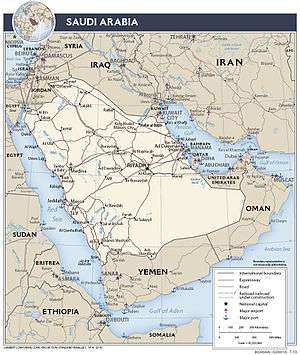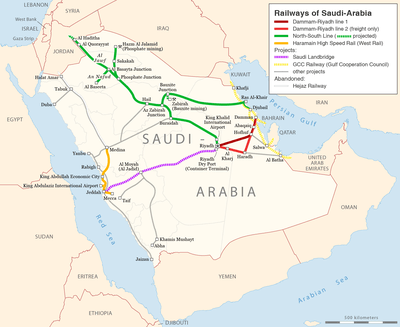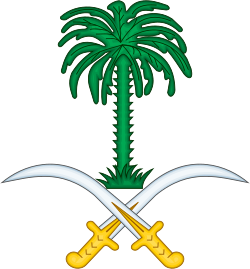Transport in Saudi Arabia
The transportation network of Saudi Arabia is facilitated through a relatively young system of roads, railways and seaways. Most of the network started construction after the discovery of oil in the Eastern Province in 1952, with the notable exception of Highway 40, which was built to connect the capital Riyadh to the economically productive Eastern Province, and later to the Islamic holy city of Mecca and the port city of Jeddah. With the arrival of petrodollars, the Kingdom of Saudi Arabia has initiated many infrastructure development projects across the country, and the extensive development of the transportation network has followed suit in support of various economic developments.
 Map of the Saudi Arabian transportation network from the 2000 CIA World Factbook | |
| Overview | |
|---|---|
| Native name | نظام النقل بالمملكة العربية السعودية |
| Owner | Ministry of Transport |
| Area served | |
| Chief executive | Saleh bin Naser al-Jaser (as Minister) |
| Headquarters | Riyadh |
| Website | https://www.mot.gov.sa/en |
| Operation | |
| Operator(s) | Ministry of Transport |
History
Road construction and development
The roads of Saudi Arabia gradually became the defining feature of the kingdom's road system as the main population centres are not only scattered all over the country but also because they faced a major challenge from the geography of the country itself; separated by deserts, valleys and mountains, among other landforms. Due to this, a reliable road network became more important and essential than other modes of transport in the kingdom.[1]
Saudi Arabia had encouraged road transport in the past by maintaining one of the lowest petrol prices in the world. Despite raising prices in 2018,[2] it is worth noting that due to limited alternative passenger transport options in the country, the gasoline fuel demand is relatively inelastic to its prices;[3] light-duty vehicles dominate the passenger transport landscape. Buses and other public transport options are limited, and walking or bicycles are hindered by the urban landscapes and harsh weather in most regions of the country.
The development of the Saudi road network can be divided into two major phases; i.e. the expansion of the modern road network from 1938 to 1970, preceding the initial development plans conceived by the Ministry of Transport, and the development and expansion after the introduction of the plans (after 1970). The two stages, pre-national planning and postnational planning, relate to the historical circumstances of the economic, political and social demands of the kingdom. The activity during the second stage greatly exceeds that during the first owing to the existence of coordinated plans, high investment and concentration of effort.[1]
Roads and expressways
Highway network
Saudi Arabia divides its highway network into two categories: expressways and main roads. The Ministry of Transport in 2014 maintained a total estimated road length of 627,000 km, of which 151,000 km were highways linking major regions of Saudi Arabia with international borders and serving as interconnecting roads between the major Saudi Arabian cities; 102,000 km were secondary roads linking major cities with other smaller cities in their respective provinces; 374,000 km were feeder roads branching out of secondary roads and serving towns, villages & agricultural areas. Another 204,000 km of roads was under construction by the end of fiscal year 2014.
Expressways & main roads
The Ministry of Transport maintains 151,000 km of major roads linking the major Saudi Arabian cities and the kingdom to its neighbors. Their website maintains a list of these roads:
| Saudi National Highway | Mashreq Highway | Length | Major cities |
|---|---|---|---|
| Highway 5 | M55 | Yemen–Jizan–Jeddah–Yanbu–Jordan | |
| Highway 10 | Highway 15–Abha–Khamis Mushait–Wadi ad-Dawasir–Kharj–UAE | ||
| Highway 15 | Yemen–Najran–Abha–Ta'if–Mecca–Medina–Tabuk–Jordan | ||
| Highway 30 | Highway 15–Bisha–Highway 40 | ||
| Highway 40 | M80 | Highway 5–Jeddah–Mecca–Ta'if–Riyadh–Dammam–Bahrain | |
| Highway 50 | |||
| Highway 60 | M30 | ||
| Highway 65 | M35 | ||
| Highway 70 | |||
| Highway 75 | |||
| Highway 80 | |||
| Highway 85 | |||
| Highway 90 | |||
| Highway 95 | M5 |
The city highways and other major highways are well maintained. The roads have been constructed to resist the consistently high temperatures and do not reflect the strong sunshine. The other city highways such as the one linking coast to coast are not as great as the inner-city highways but the government is now working on rebuilding those roads. In October 2013, a group of auto enthusiasts drove some 2,000 km (1,200 mi) through Saudi Arabia in search of the best driving road, and named the Jeddah-Taif-Al-Hada highway as "motoring nirvana".[4]
On 19 February 2018, it was announced that four of the main Saudi motorways that allow for high speed will grant a speed limit increase to users from 120 kmph to 140 kmph. Those motorways are (Mecca-Medina), (Riyadh-Dammam), (Riyadh-Gassim) and finally (Riyadh-Taif).[5]
Economic impact
The development of a road network plays an important role in the economic development of a country and therefore, the mileage of paved roads existing in a country is often used as an index to assess the extent of its development. The proper development of transport road network not only reduces the cost of transportation both in terms of money and time but also helps in the integration of various regions within the country and better understanding of neighbouring countries at the international level. The transport road network in Saudi Arabia contributed to the development of the country by bringing in direct benefits from its role in the development of some sectors such as minerals, agriculture, industry and commerce.[1]
Ports and waterways
Saudi Arabia has a well development sea transport network developed primarily to support the transport of petrochemicals. Saudi Ports Authority is the ports management organization in the country, overseeing the operations. The largest seaport in Saudi Arabia located on the Red Sea. This port makes 80% of maritime flow.[6]
The major ports in the country are as follows;
Persian Gulf
- King Abdul Aziz Port, Dammam
- Jubail
- Ras Tanura
- Khafji
- Ra's al-Khair (under construction)
Air transportation
There are an estimated 203 airports in Saudi Arabia (2003 est.).
Airports with paved runways
total:
61
over 3,047 m:
32
2,438 to 3,047 m:
13
1,524 to 2,437 m:
12
914 to 1,523 m:
2
under 914 m:
2 (2003 est.)
Airports with unpaved runways
total:
133
over 3,047 m:
6
2,438 to 3,047 m:
5
1,524 to 2,437 m:
75
914 to 1,523 m:
38
under 914 m:
14 (2003 est.)
Heliports
9 (2009 est.)
Commercial Helicopter
In 2019, the Saudi Public Investment Fund (PIF) launched the first commercial helicopter that will serve to transport customers within the major Saudi cities and to take them to different tourism destinations.[7]
Rail transport

Although the long-abandoned Hejaz railway had been built during the Ottoman occupation, the first railway to be built in modern Saudi Arabia was the Riyadh-Dammam railway. It was launched by King Abdulaziz in 1951. In 2018, the railway transported 1.8 million passengers and 700,000 goods. Currently, the railway is planned to undergo further development.[8]
As a result of over-reliance on road and air travel, rail transport has not received a similar level of investment in Saudi Arabia. However, there are now plans for expansion within the kingdom's railway infrastructure. The length of the new railway is 1,500 km.[9] Some of these plans are:
- The Saudi Landbridge Project is a project that aims to link the port cities of Jeddah, Dammam, and Jubail. It will also pass through Riyadh and serve its dry port. The line linking Riyadh and Jeddah is planned to be approximately 950 km (590 mi) long, whilst the line connecting the two cities of Dammam and Jubail should be around 150 km (93 mi).[10]
- The Haramain High Speed Rail Project (HHR) underway in the Western province, connecting Makkah, Jeddah, King Abdullah Economic City and Madinah city with a 453 km (281 mi) long railway line. This semi-electric passenger double line will be created to transport the large number of Hajj pilgrims, which the SRO considers transportation for, an urgent matter. It will be up and running by May 2018.[11] By 2019, the railway has been working in almost full capacity with the speed of 300 km/hour.[12]
- The Al Mashaaer Al Mugaddassah Metro Southern Line is part of the Makkah Metro rail transit system, which was developed in Makkah city. This is a 18.1 kilometers (11.2 miles) track developed as exclusive shuttle a predicted 8 million pilgrims between Mecca, Mount Arafat, Muzdalifa and Mina.
- The Riyadh Metro is a 6 line rapid transit system under construction in the capital. As of April 2018, it is 71% completed. It is scheduled for a soft opening in 2019, the full network is expected to be fully operational by 2021.
References
- Aldagheiri, M. "The role of transport roads network in the economic development in Saudi Arabia" (PDF). Qassim University College of Arabic and Sociology.
- "Saudi Arabia hikes fuel price". Saudi Gazette.
- Algunaibet, Ibrahim, Walid Matar (2017). "The responsiveness of fuel demand to gasoline price change in passenger transport: a case study of Saudi Arabia". doi:10.1007/s12053-018-9628-6.CS1 maint: multiple names: authors list (link)
- "McLaren 12C. Saudi Arabia. The Hidden Kingdom - crankandpiston.com". crankandpiston.com. 21 October 2013.
- "Arab News".
- "Why Saudi Arabia". Invest Saudi. Retrieved 2019-02-17.
- "Saudi Public Investment Fund launches Kingdom's first commercial helicopter operator". Arab News. 2019-03-11. Retrieved 2019-03-12.
- "How Saudi Arabia is improving its railways". Arab News. 2019-03-04. Retrieved 2019-03-04.
- "Transport and Logistics - Sectors & Opportunities". Invest Saudi. Retrieved 2019-02-16.
- "Landbridge Project", Saudi Railways Organization. Retrieved on 17 August 2017
- "[Haramain] Project Brief", Saudi Railways Organization. Retrieved on 17 August 2017.
- "How Saudi Arabia is improving its railways". Arab News. 2019-03-04. Retrieved 2019-03-04.
External links
| Wikimedia Commons has media related to Transport in Saudi Arabia. |
